Investigation on Initial Shell Solidification and the Effect of Negative Strip Time on Oscillation Marks during Continuous Casting
Abstract
1. Introduction
2. Mathematical Model
2.1. Assumptions
- (1)
- Molten steel is an uncompressible Newtonian fluid, slag is a non-Newtonian fluid;
- (2)
- The model was isothermal at the beginning;
- (3)
- The taper and arc of the mold were neglected;
- (4)
- The fluid flow and heat transfer in the mold are symmetric; hence, only half of the mold was analyzed.
2.2. Governing Equation
2.3. Computing Domain and Mesh
2.4. Boundary Conditions
3. Model Verification
3.1. Temperature, Phase Distribution, and Flow of Fluid in Mold
3.2. Shell Thickness and Oscillation Marks
4. Discussion
4.1. Slag Infiltration
4.2. Evolution of the Shell Surface and Pressure Variation of the Shell Surface
4.3. Formation of Oscillation Marks
4.4. Comparison of Casting with and without Negative Strip Stage
5. Conclusions
- 1.
- The predicted flow pattern, slag consumptions, and oscillation mark depth were compared with the measured results from plants in this study; the results showed a good agreement and the validity of the model was verified.
- 2.
- The flow behavior of the slag was related to the movement of the slag rim, and the OM was formed during the . During the , when the slag rim attached to the mold wall and moved down with it, the movement of liquid slag near the meniscus was affected by the slag rim, and strong backflow of slag occurred near the initial shell, resulting in a sudden increase in the pressure on the surface of the shell and an obvious depression OM was formed on the outer surface of the shell.
- 3.
- With decreasing to no- during one cycle, the depth of OM, total slag thickness, solid slag thickness, and liquid slag thickness decreased, the surface of the slab was smoother, and the quality of the slab was significantly improved.
- 4.
- The downward velocity of the slag on the solid–liquid slag interface and the downward velocity of the slag on the shell surface increased with the increase in the distance from the meniscus. The downward velocity increased with decreasing to no- during one cycle, which was related to the mold oscillation velocity, slag thickness, and casting speed.
- 5.
- The upward shear stress on the shell surface increased with the increase in the distance from the meniscus. With decreasing to no- during one cycle, the upward shear stress on the shell surface increased, which was related to the relative velocity of the mold and shell and the thickness of the liquid slag.
- 6.
- The depth of the oscillation mark could be reduced by shorting , and the quality of the slabs was improved. The results provide a new perspective for reducing oscillation marks and are of great significance for improving casting slabs’ quality.
Author Contributions
Funding
Data Availability Statement
Conflicts of Interest
References
- Konishi, J.; Militzer, M.; Samarasekera, I.V.; Brimacombe, J.K. Modeling the formation of longitudinal facial cracks during continuous casting of hypoperitectic steel. Metall. Mater. Trans. B 2002, 33, 413–423. [Google Scholar] [CrossRef]
- Choudhary, S.; Ganguly, S. Morphology and Segregation in Continuously Cast High Carbon Steel Billets. ISIJ Int. 2007, 47, 1759–1766. [Google Scholar] [CrossRef]
- Choudhary, S.K.; Ganguly, S.; Sengupta, A.; Sharma, V. Solidification morphology and segregation in continuously cast steel slab. J. Mater. Process. Technol. 2017, 243, 312–321. [Google Scholar] [CrossRef]
- Kamaraj, A.; Dash, A.; Murugaiyan, P.; Misra, S. Investigation on Mold Flux Melting and Consumption During Continuous Casting of Liquid Steel. Metall. Mater. Trans. B 2020, 51, 2159–2170. [Google Scholar] [CrossRef]
- Cibulka, J.; Krzok, R.; Hermann, R.; Bocek, D.; Cupek, J.; Michalek, K. Impact of Oscillation Parameters on Surface Quality of Cast Billets. Arch. Metall. Mater. 2016, 61, 283–288. [Google Scholar] [CrossRef]
- Takeuchi, E.; Brimacombe, J.K. The formation of oscillation marks in the continuous casting of steel slabs. Metall. Mater. Trans. B 1984, 15, 493–509. [Google Scholar] [CrossRef]
- Takeuchi, E.; Brimacombe, J.K. Effect of oscillation-mark formation on the surface quality of continuously cast steel slabs. Metall. Mater. Trans. B 1985, 16, 605–625. [Google Scholar] [CrossRef]
- Badri, A.; Natarajan, T.T.; Snyder, C.C.; Powers, K.D.; Mannion, F.J.; Byrne, M.; Cramb, A.W. A mold simulator for continuous casting of steel: Part II. The formation of oscillation marks during the continuous casting of low carbon steel. Metall. Mater. Trans. B 2005, 36, 373–383. [Google Scholar] [CrossRef]
- Badri, A.; Natarajan, T.T.; Snyder, C.C.; Powers, K.D.; Mannion, F.J.; Cramb, A.W. A mold simulator for the continuous casting of steel: Part I. The development of a simulator. Metall. Mater. Trans. B 2005, 36, 355–371. [Google Scholar] [CrossRef]
- Lopez, P.E.R.; Lee, P.D.; Mills, K.C. Explicit modelling of slag infiltration and shell formation during mould oscillation in continuous casting. ISIJ Int. 2010, 50, 425–434. [Google Scholar] [CrossRef]
- Lopez, P.E.R.; Lee, P.D.; Mills, K.C.; Santillana, B. A New Approach for Modelling Slag Infiltration and Solidification in a Continuous Casting Mould. ISIJ Int. 2010, 50, 1797–1804. [Google Scholar] [CrossRef]
- Yan, X.; Jia, B.; Wang, Q.; He, S.; Wang, Q. Mold Nonsinusoidal Oscillation Mode and Its Effect on Slag Infiltration for Lubrication and Initial Shell Growth during Steel Continuous Casting. Metals 2019, 9, 418. [Google Scholar] [CrossRef]
- Zhang, S.; Wang, Q.; He, S.; Wang, Q. Study of the Mechanism of Liquid Slag Infiltration for Lubrication in Slab Continuous Casting. Metall. Mater. Trans. B 2018, 49, 2038–2049. [Google Scholar] [CrossRef]
- Deng, Y.; Zhang, Y.; Wang, Q.Q.; Wang, Q. Study of Mold Oscillation Parameters and Modes on Slag Lubrication in Slab Continuous Casting. JOM 2018, 70, 2909–2916. [Google Scholar] [CrossRef]
- Zhang, X.-b.; Chen, W.; Zhang, L.-f. A coupled model on fluid flow, heat transfer and solidification in continuous casting mold. China Foundry 2017, 14, 416–420. [Google Scholar] [CrossRef]
- Zhang, X.; Chen, W.; Scheller, P.R.; Ren, Y.; Zhang, L.F. Mathematical Modeling of Initial Solidification and Slag Infiltration at the Meniscus of Slab Continuous Casting Mold. JOM 2019, 71, 78–87. [Google Scholar] [CrossRef]
- Zhang, X.; Dan, Z.; Chen, W.; Zhang, L.; Wang, Q. Mathematical Modeling on Slag Consumption and Lubrication in a Slab Continuous Casting Mold. Metall. Mater. Trans. B 2021, 52, 322–338. [Google Scholar] [CrossRef]
- Yang, J.; Cai, Z.Z.; Zhu, M.Y. Transient Thermo-fluid and Solidification Behaviors in Continuous Casting Mold: Evolution phenomena. ISIJ Int. 2018, 58, 299–308. [Google Scholar] [CrossRef]
- Yang, J.; Meng, X.; Zhu, M. Transient Thermo-fluid and Solidification Behaviors in Continuous Casting Mold: Oscillation Behaviors. ISIJ Int. 2018, 58, 2071–2078. [Google Scholar] [CrossRef]
- Liovic, P.; Liow, J.-L.; Rudman, M. A Volume of Fluid (VOF) Method for the Simulation of Metallurgical Flows. ISIJ Int. 2001, 41, 225–233. [Google Scholar] [CrossRef]
- Brackbill, J.U.; Kothe, D.B.; Zemach, C. A continuum method for modeling surface tension. J. Comput. Phys. 1992, 100, 335–354. [Google Scholar] [CrossRef]
- Launder, B.E.; Spalding, D.B. Lectures in Mathematical Models of Turbulence; Academic Press: London, UK, 1972; 169p, Available online: https://lib.ugent.be/catalog/rug01:000004139 (accessed on 2 January 2023).
- Brent, A.D.; Voller, V.R.; Reid, K.J. Enthalpy-porosity technique for modeling convection-diffusion phase change: Application to the melting of a pure metal. Numer. Heat Transf. 1988, 13, 297–318. [Google Scholar] [CrossRef]
- Ho, Y.-H.; Hwang, W.-S. The Analysis of Molten Steel Flow in Billet Continuous Casting Mold. ISIJ Int. 1996, 36, 1030–1035. [Google Scholar] [CrossRef]
- Yu, Y.; Luo, X.C. Identification of heat transfer coefficients of steel billet in continuous casting by weight least square and improved difference evolution method. Appl. Therm. Eng. 2017, 114, 36–43. [Google Scholar] [CrossRef]
- Shin, H.J.; Kim, S.H.; Thomas, B.G.; Lee, G.G.; Park, J.M.; Sengupta, J. Measurement and prediction of lubrication, powder consumption, and oscillation mark profiles in ultra-low carbon steel slabs. ISIJ Int. 2006, 46, 1635–1644. [Google Scholar] [CrossRef]

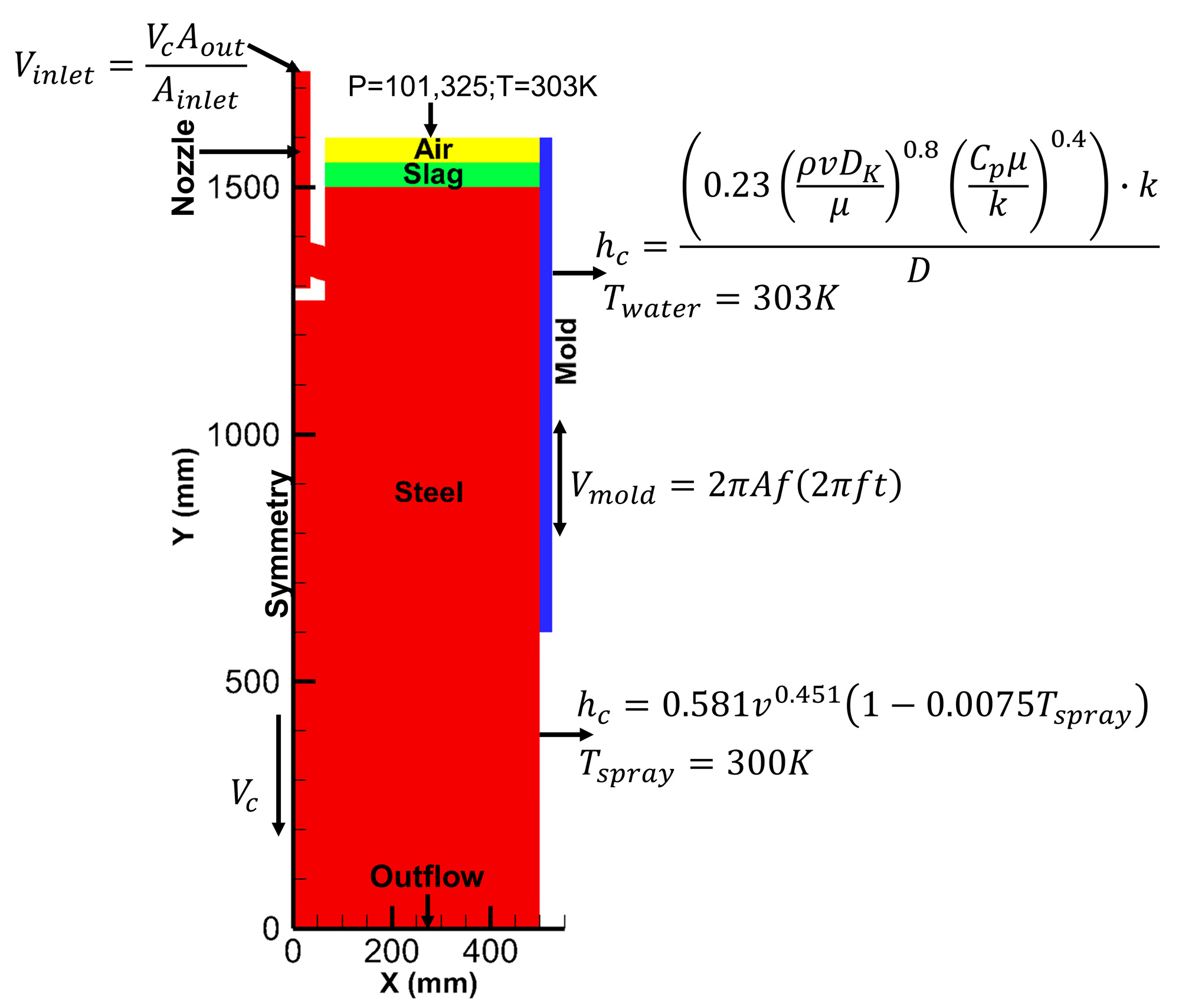

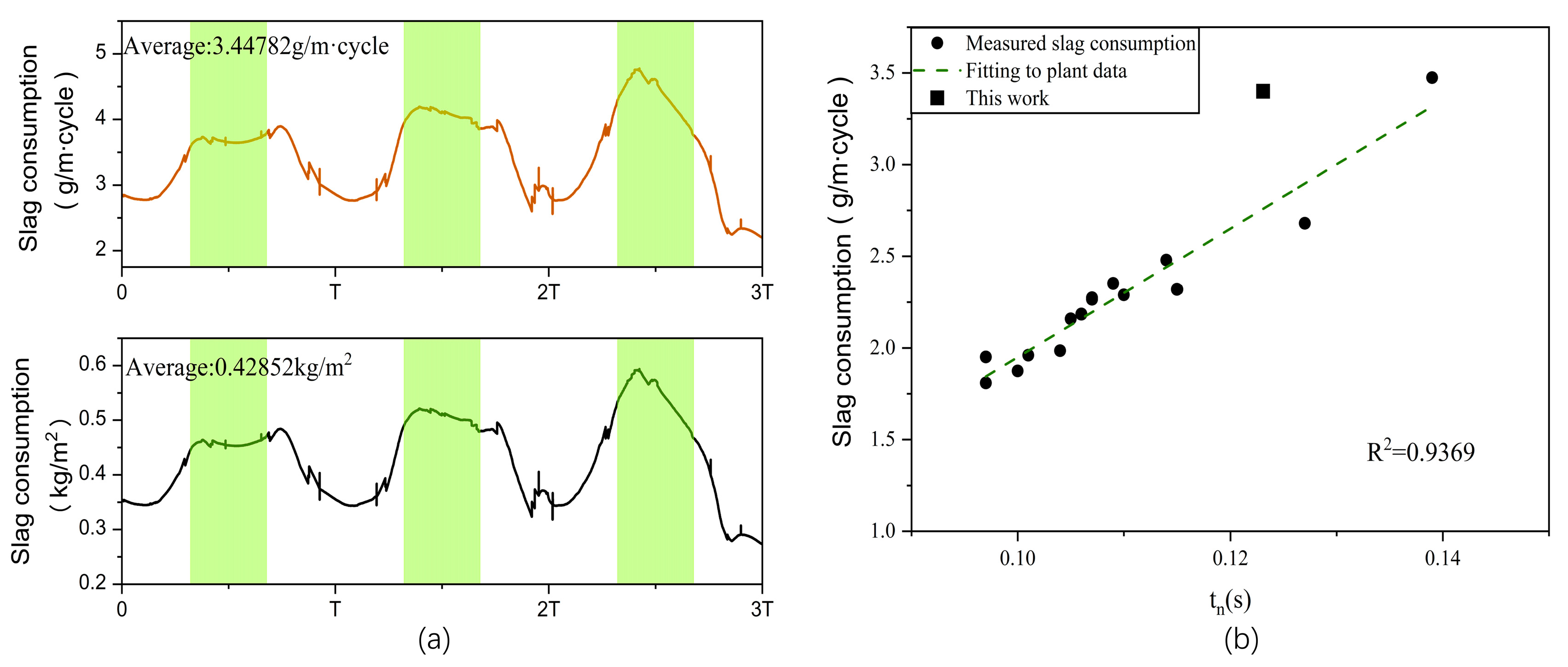
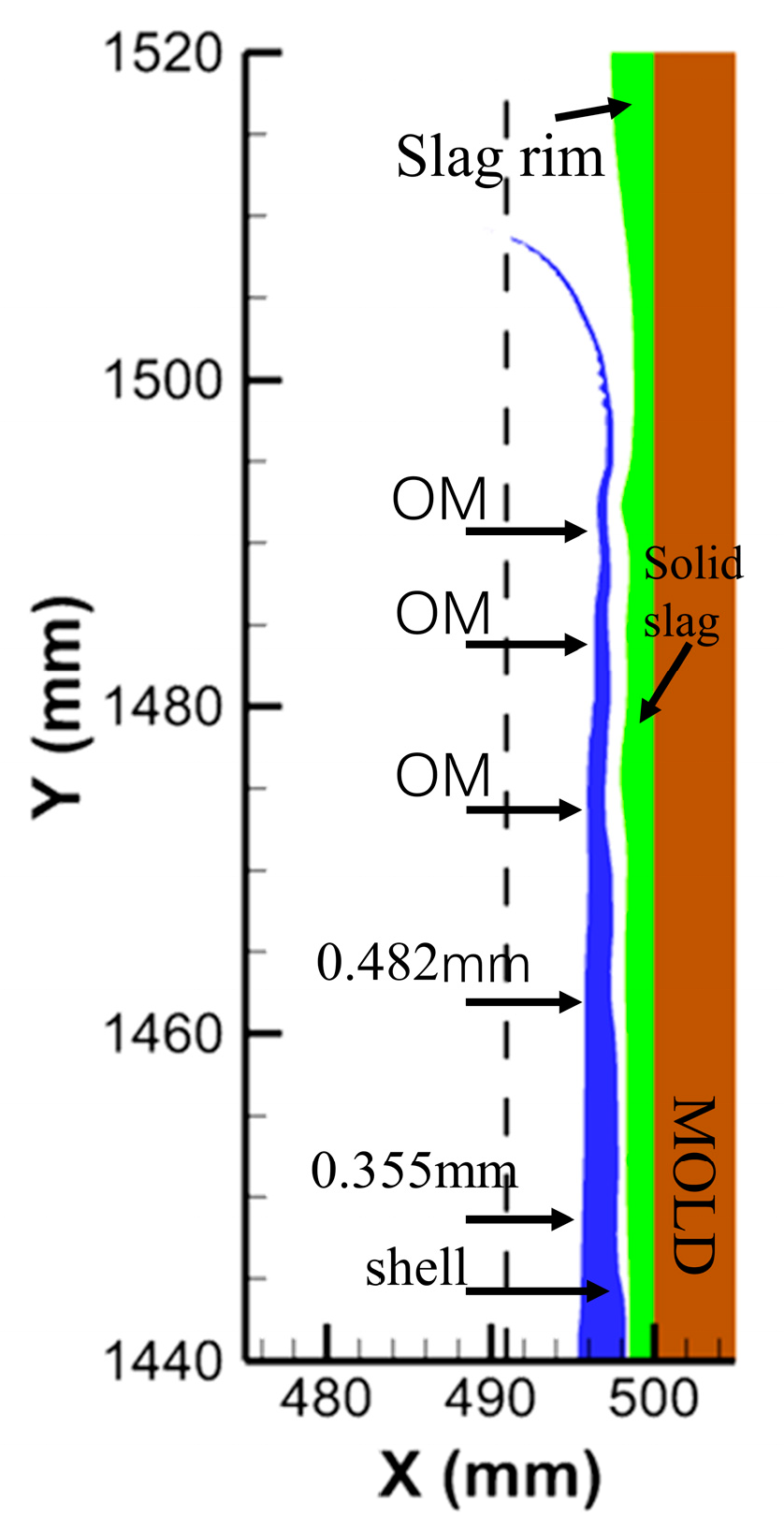

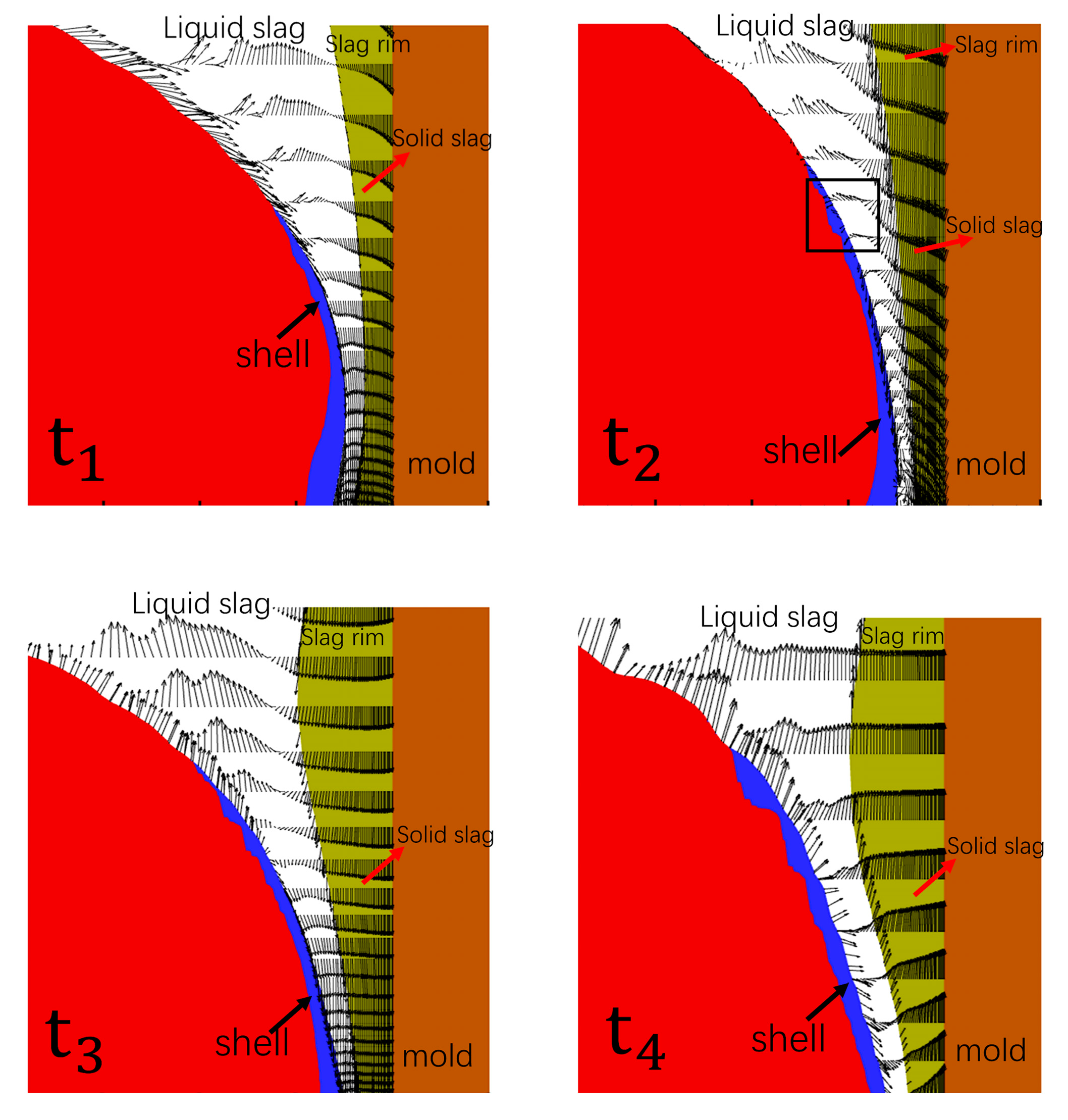

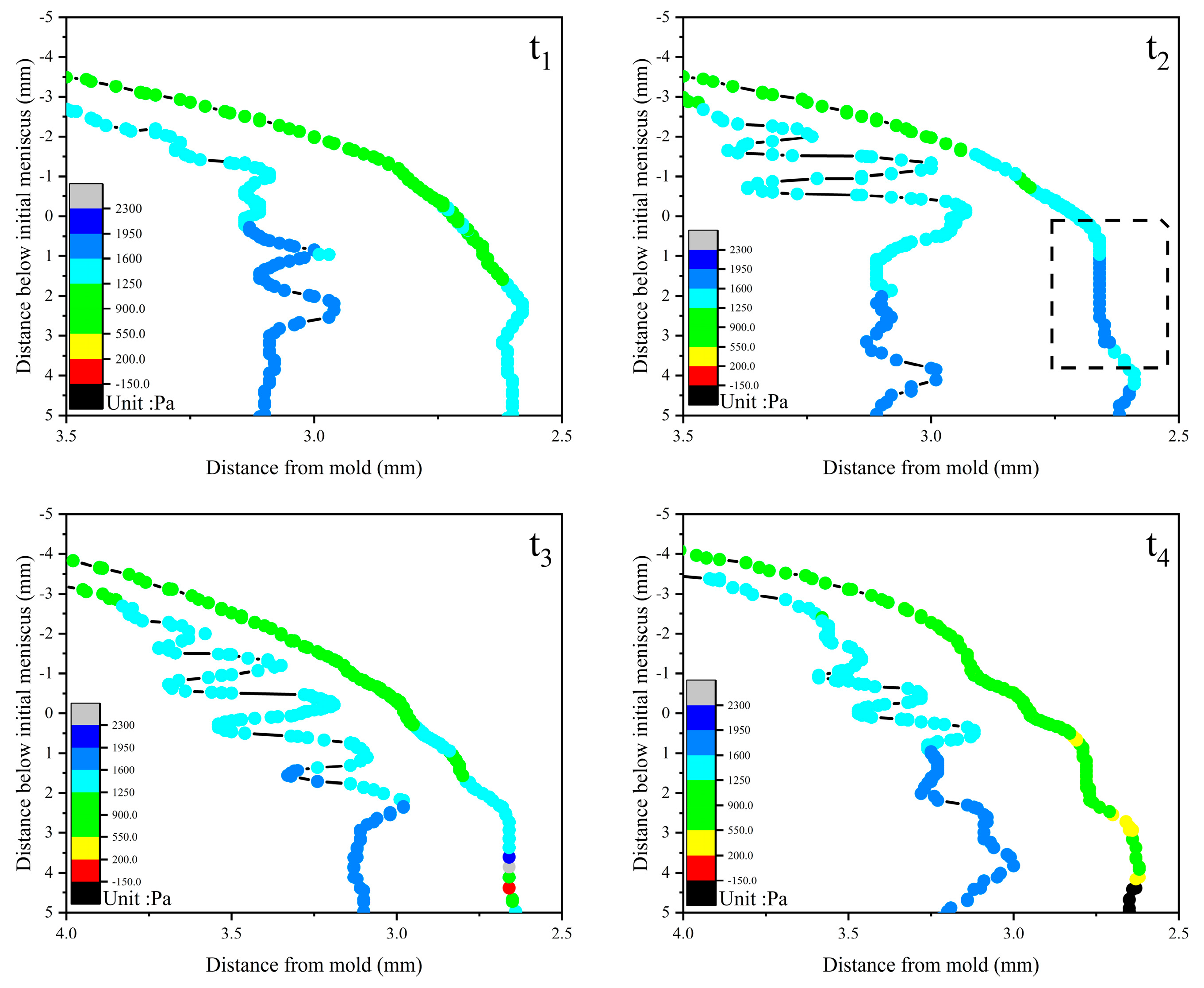
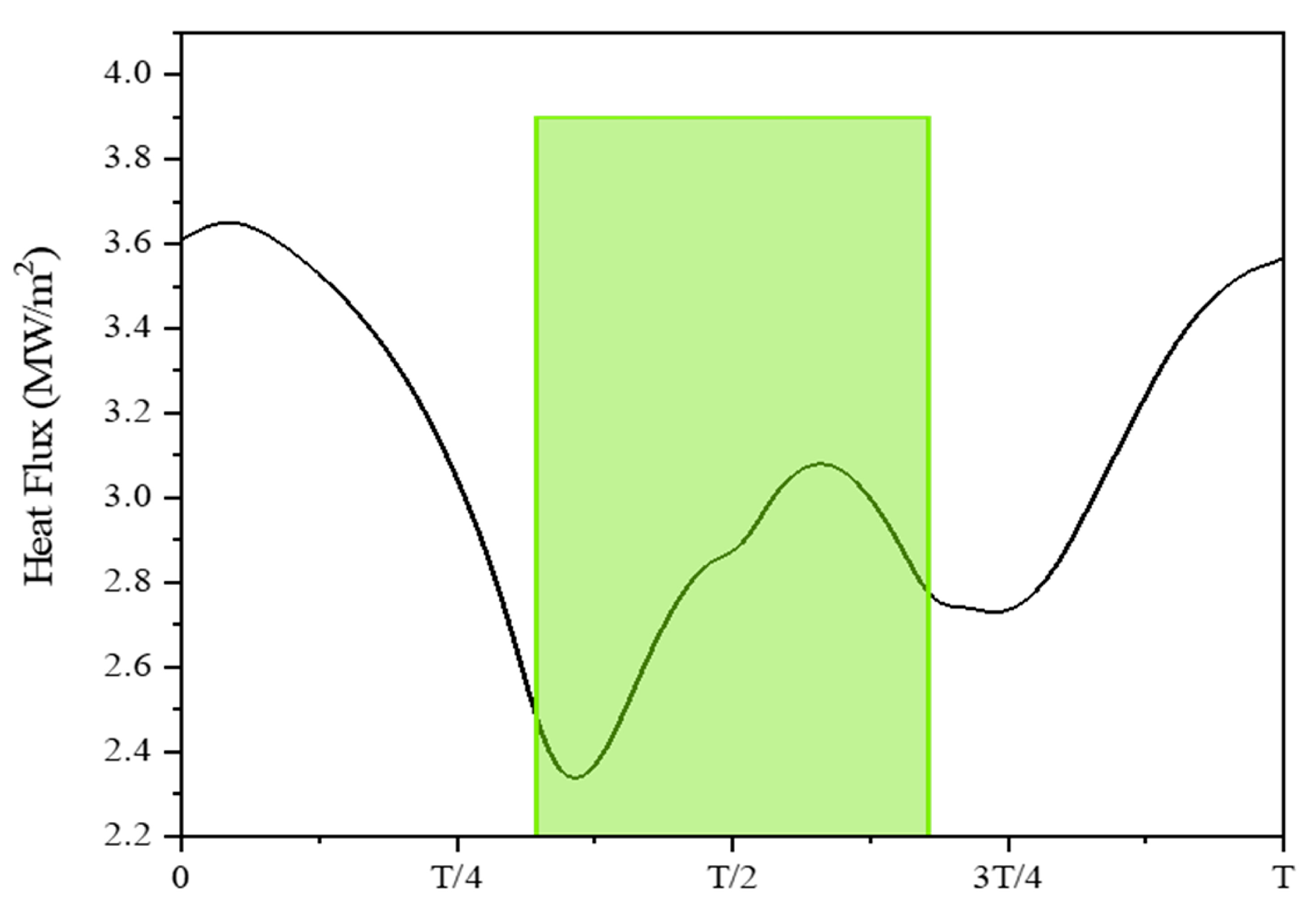
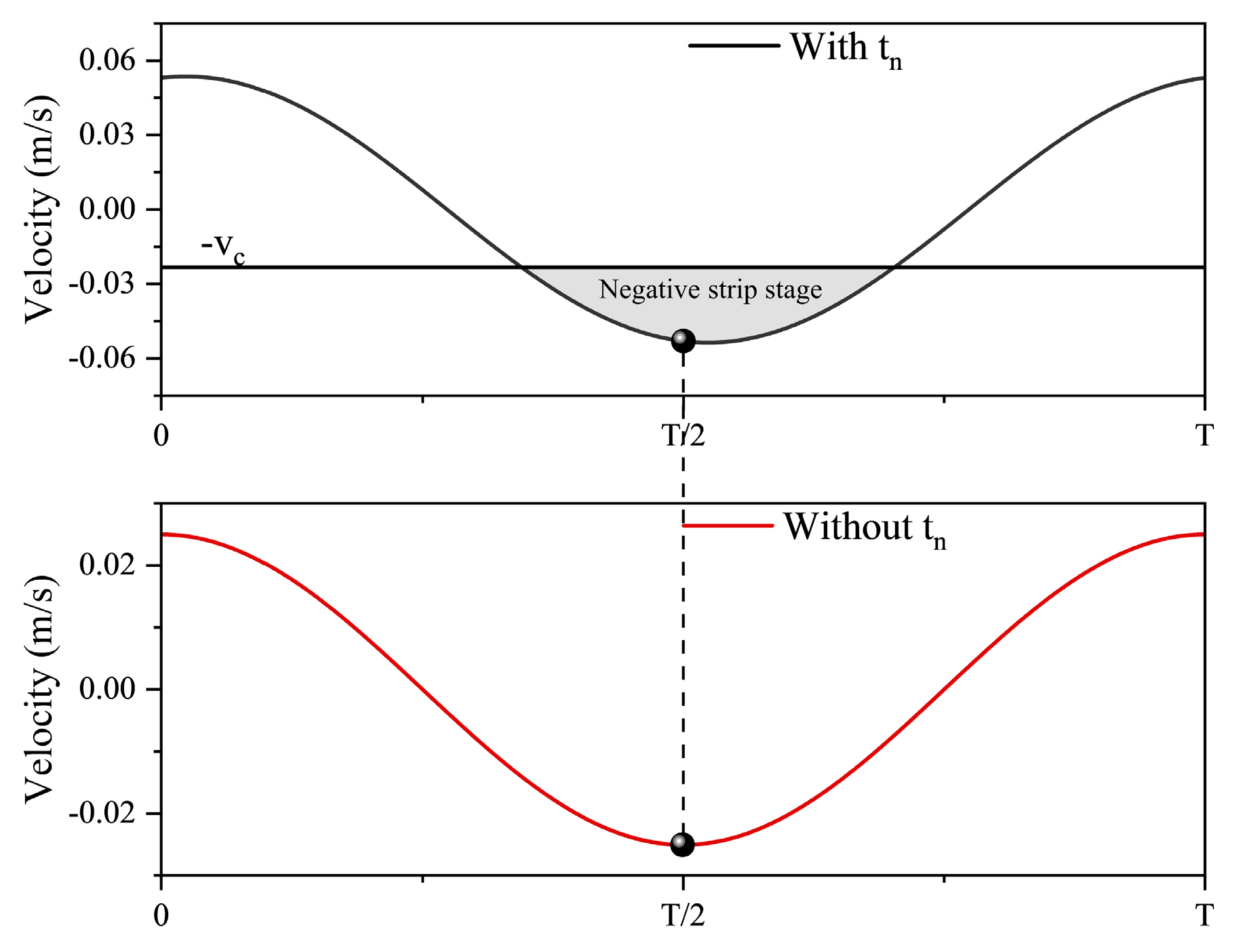



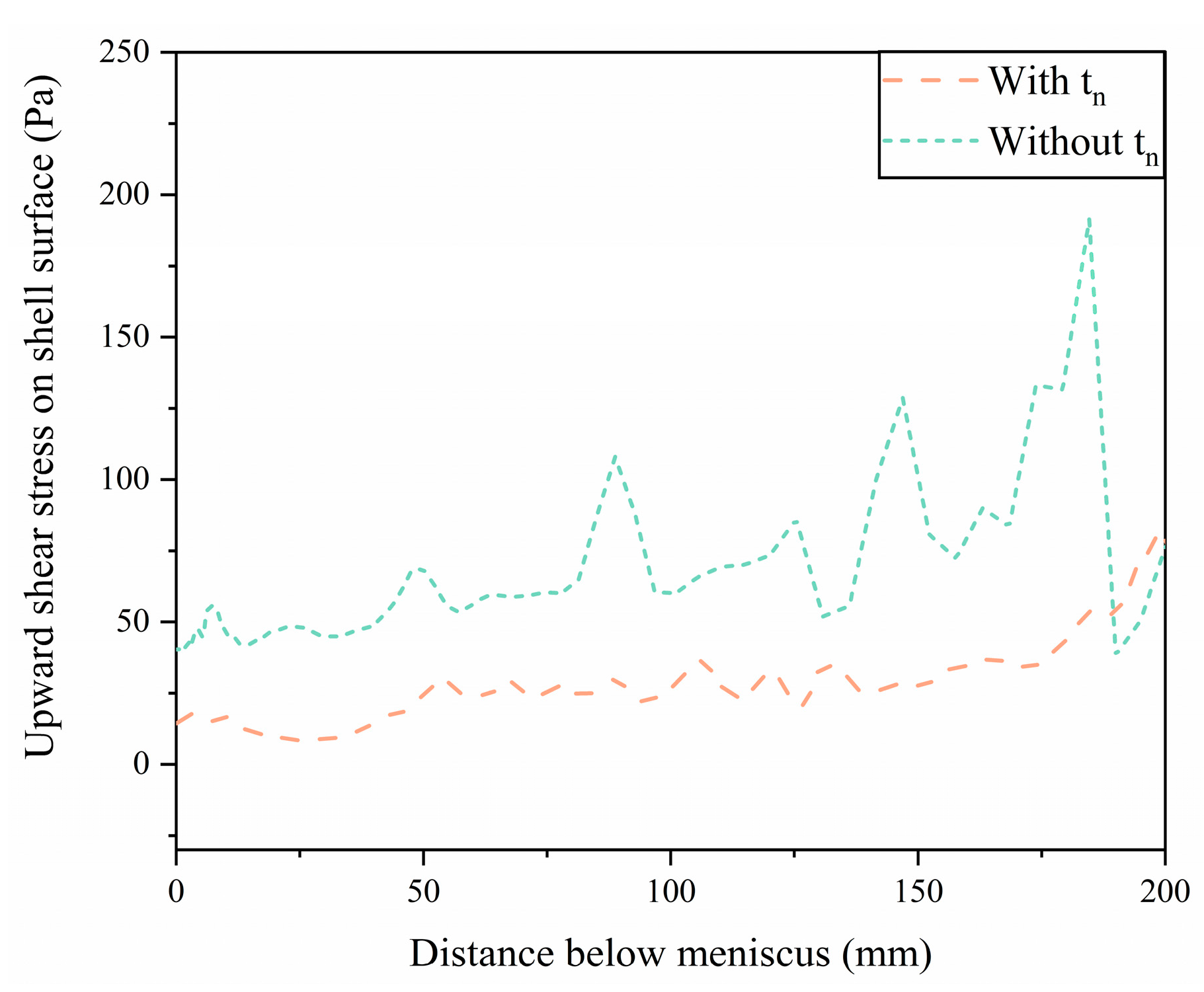
| Parameters | Value |
|---|---|
| Mold width(m) | 1.0 |
| Mold length(m) | 1.0 |
| Simulation length (m) | 1.6 |
| Nozzle inner diameter (m) | 0.056 |
| Height of the SEN exit port (m) | 0.078 |
| Exit port angle | 15° |
| Casting speed (m/min) | 1.4 |
| Phase | Parameters | Valus |
|---|---|---|
| Steel | Density, kg/m3 | 7020 |
| Viscosity, kg/(m·s) | 0.0062 | |
| Heat capacity, J/(kg·K) | 680 | |
| Thermal conductivity, W/(m·K) | 34 | |
| Latent heat, J/kg | 270,000 | |
| Liquidus temperature, K | 1805 | |
| Solidus temperature, K | 1790 | |
| Slag | Density, kg/m3 | 2500 |
| Viscosity16), kg/(m·s) | ||
| Heat capacity, J/(kg·K) | 830 | |
| Mold | Thermal conductivity16), W/(m·K) | |
| Break temperature, K | 1352 | |
| Density, kg/m3 | 8973 | |
| Heat capacity, J/(kg·K) | 390 | |
| Thermal conductivity, W/(m·K) | 387 | |
| Interfacial tension of slag–steel, (N/m) | 1.3 | |
| Interfacial tension of slag–air, (N/m) | 0.8 | |
| Mode | (m/min) | (cpm) | (mm) | (s) | (mm) | (mm) | (mm) | (mm) | (mm) | |
|---|---|---|---|---|---|---|---|---|---|---|
| Sin | 1.4 | 174 | 2.95 | 0.123 | 0.81 | 1.8 | 2.61 | 8.92 | 0.47 | |
| Sin | 1.5 | 3 | 0 | 0.43 | 1.27 | 1.7 | 6.49 | 0.016 |
Disclaimer/Publisher’s Note: The statements, opinions and data contained in all publications are solely those of the individual author(s) and contributor(s) and not of MDPI and/or the editor(s). MDPI and/or the editor(s) disclaim responsibility for any injury to people or property resulting from any ideas, methods, instructions or products referred to in the content. |
© 2023 by the authors. Licensee MDPI, Basel, Switzerland. This article is an open access article distributed under the terms and conditions of the Creative Commons Attribution (CC BY) license (https://creativecommons.org/licenses/by/4.0/).
Share and Cite
Cao, M.; Liu, Y.; Zhang, X. Investigation on Initial Shell Solidification and the Effect of Negative Strip Time on Oscillation Marks during Continuous Casting. Metals 2023, 13, 726. https://doi.org/10.3390/met13040726
Cao M, Liu Y, Zhang X. Investigation on Initial Shell Solidification and the Effect of Negative Strip Time on Oscillation Marks during Continuous Casting. Metals. 2023; 13(4):726. https://doi.org/10.3390/met13040726
Chicago/Turabian StyleCao, Minghui, Yuanhe Liu, and Xingzhong Zhang. 2023. "Investigation on Initial Shell Solidification and the Effect of Negative Strip Time on Oscillation Marks during Continuous Casting" Metals 13, no. 4: 726. https://doi.org/10.3390/met13040726
APA StyleCao, M., Liu, Y., & Zhang, X. (2023). Investigation on Initial Shell Solidification and the Effect of Negative Strip Time on Oscillation Marks during Continuous Casting. Metals, 13(4), 726. https://doi.org/10.3390/met13040726





